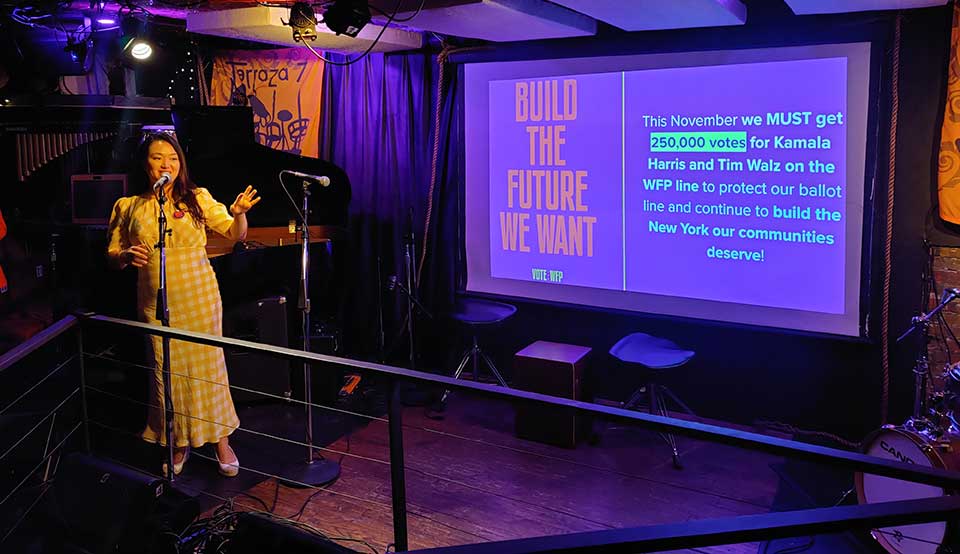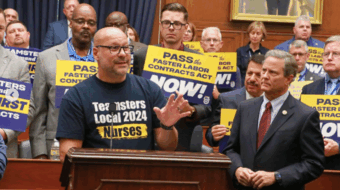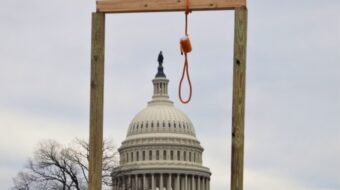
Queens NYC––A few dozen people gathered at Terraza 7 on Tuesday to watch the first televised debate between Vice President Kamala Harris and Donald Trump. The gathering was hosted by the New York Working Families Party (WFP) and featured speakers like city council members Julie Won, Tiffany Caban, and Shahana Hanif, as well as State Assemblyperson-elect Claire Valdez. WFP organizers walked around with wristbands for free drinks and tacos.
With just 55 days to go before millions cast their ballots to decide the future of the United States, they stressed that they would need at least 250,000 voters in New York to cast their vote for the Harris-Walz ticket in order to maintain their ballot status and campaign financing. After the WFP cast their lot with actress Cynthia Nixon in the Democratic primary in 2018, the sitting governor, Andrew Cuomo, struck back with higher benchmarks for ballot access. Before rule changes were implemented in 2020, the WFP only needed 50,000 votes to qualify. Now, 130,000 votes or 2% of the total vote count from the last presidential election is needed—whichever is higher.
New York offers an attractive public campaign finance program that matches up to $12 for each dollar for state legislative offices and up to $6 for each dollar raised for statewide offices. In New York City, candidates can take advantage of an $8-to-1 public financing program. These programs offer a lifeline to candidates who represent working-class constituencies and choose to forgo corporate money. Without it, they are at the mercy of big money interests.
People’s World spoke with Jasmine Gripper, co-director of Working Families Party NY regarding the stakes of this year’s elections in New York. Gripper pointed out that New York’s status as “triple-blue”––Democrat-controlled across the governorship, legislature, and state senate––is new and precarious. “We worked really hard to change the dynamics of our state,” she said. “When we were able to win big, people saw the difference. We were able to raise the minimum wage, we were able to fund our schools, pass the DREAM Act, pass protections for renters at the state level, all of these things had been unlocked when we switched the hands of power and got more progressives elected.”
The Working Families Party works through a system called fusion voting, where they are able to both run their own candidates and also endorse Democrats running for office. For instance, New York State Attorney General Leticia James began her political career by running as a Working Families Party candidate for the New York City Council.
“Elected officials know how many votes they get on the Working Families Party line,” Gripper said. “There are some portions of the state where the margin of victory for Democrats is their total on the Working Families Party line. That gives us more power. They answer the phone when we call.”
The progress that the WFP has made in its 26-year history presents a serious challenge to the Democratic machine in Albany. According to Gripper, the tensions came to a head when the WFP endorsed Cynthia Nixon in the state primary for Governor, the incumbent Andrew Cuomo set his sights on eliminating the WFP with a number of political gambits, including the creation of a new political party “Women’s Equality Party” (WEP) to confuse voters at the ballot box. When WFP progressives won public campaign financing, the response was to raise ballot access requirements. Yet, as Gripper pointed out with a smile: “He’s gone and we’re still here.”
The Democratic machine in Albany is now increasingly appealing to center-right voters as opposed to mobilizing their base. They have rolled over on abortion rights, LGBT rights, and congestion pricing to finance badly needed MTA improvements. Democratic congressional incumbent Tom Suozzi (NY-3) is brandishing the need for stricter immigration policy while John Avlon, NY-1’s challenger to Republican Nick Lalota, brands himself “neither right nor left” and is the co-founder of No Labels. WFP member Jamaal Bowman himself was ousted during the primary season by George Latimer, a staunch pro-Israel advocate who took millions from the Israel lobby.
Could these political maneuvers account for the Democrats’ poor turnout performance? According to New York State electoral data, 43% of registered Democrats came out to vote in the primaries for State Assembly in 2022. And only a quarter of registered Democrats (841,967 of 3.4 million eligible voters) came out to vote in the Democratic Mayoral Primaries for New York City.
Meanwhile, the 2.9 million registered Republicans turned out at higher rates: 74% of them turned out for the 2022 State Assembly election. A whopping 77% turned out to vote in the 2022 House races, as opposed to the 47% of Democrats who did the same.
“The Democratic leadership in New York has been moving more centrist and moving more conservative. If the WFP loses or takes a blow, they take it as ‘progressive issues are toxic’, scary, too radical. But the reality is that most New Yorkers agree with us,” Gripper noted.
New York is now, as Gripper points out, a battleground state when it comes to congressional representation. Redistricting has not only confused voters but also wiped out incumbent advantage in some areas, as seen by Jamaal Bowman’s loss earlier this year. “Everyone was worried [in 2022] that there was going to be a ‘red wave’ across the country. There was no red wave anywhere else but in New York,” she said. “As a result of the seats that were lost in New York, Republicans are now in control of the House.”
Some of the new Republican congressmen, like Marc Molinaro of newly redistricted D-19, are already regurgitating the racist lies Trump told on the debate stage about migrants and asylum seekers. But he won the 2022 election by a slim margin of 1.6%—4,490 votes made the difference.
That is what the WFP motivated at the debate watch party: the dual threat of a more entrenched right-wing in New York and losing progressive access to the ballot. The response? To inform, mobilize, and organize. A new organization that includes WFP, Battleground New York, is working with AFSCME, CWA, 1199 SEIU, NYSNA, and SEIU 32BJ to flip four Republican congressional seats while maintaining their incumbency in two other districts. If successful, the 10/16 split in Congress would switch to 6/20 in favor of the Democrats. With volunteers needed to knock on doors to make it happen, this presents powerful leverage for progressive and labor forces. If the candidates succeed with a substantial margin of WFP votes, this would further shore up progressive power in the state.
Unlike other third parties that emerge every four years to grab headlines, the WFP is active between elections in building power, something that Gripper pointed out. “We’re not here to be a protest vote. We are a political party aiming to get governing power. We want to be able to control and run our cities for the people and by the people.”










